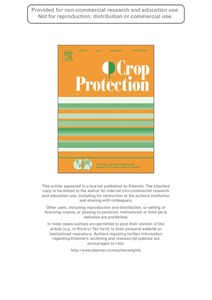| dc.contributor.author | Wagacha, M. |
| dc.contributor.author | Mutegi, C. |
| dc.contributor.author | Karanja, L.W. |
| dc.contributor.author | Kimani, J. |
| dc.contributor.author | Christie, M.E. |
| dc.date.accessioned | 2019-12-04T11:03:54Z |
| dc.date.available | 2019-12-04T11:03:54Z |
| dc.date.issued | 2013-10 |
| dc.identifier.citation | Wagacha, M., Mutegi, C., Karanja, L.W., Kimani, J. & Christie, M.E. (2013). Fungal species isolated from peanuts in major Kenyan markets: Emphasis on Aspergillus section Flavi. Crop Protection, 52, 1-9. |
| dc.identifier.issn | 0261-2194 |
| dc.identifier.uri | https://hdl.handle.net/20.500.12478/1278 |
| dc.description.abstract | A survey was conducted in Nairobi, Nyanza and Western provinces in Kenya between March and July2009 with 1263 peanut products sampled out of which 705 samples underwent microbial analysis. Thestudy aimed at determining the incidence of fungal species e emphasis on Aspergillus section Flavi eassociated with peanut products. A 0.5 kg representative sample was obtained from each surveyedvendor and the colony forming units (CFU) of fungal species determined. The samples were also analyzedfor total aflatoxin level while isolates of Aspergillus flavus and Aspergillus parasiticus were screened forproduction of aflatoxin B1, B2, G1 and G2. Eight fungal species were detected in the samples and were indecreasing order of CFU/g of sample: A. flavus S-strain (467), A. flavus L-strain (341), Penicillium spp.(326), Aspergillus niger (156), Aspergillus tamari (27), Aspergillus alliaceus (21), A. parasiticus (10), andAspergillus caelatus (5). The overall incidence of A. flavus S-strain in samples from Nairobi was 92 and1425% higher than samples from Nyanza and Western regions, respectively. The combined incidence ofA. flavus and A. parasiticus was varied significantly (p _ 0.05) with peanut product: peanut flour (69%),shelled raw peanuts (53%), spoilt peanuts (49%), boiled podded peanuts (45%), podded peanuts (39%),peanut butter (31%), fried peanuts (22%) and roasted peanuts (20%). Seventy three percent of A. flavusand A. parasiticus isolates produced at least one of the aflatoxin types, with 66% producing aflatoxin B1.The total aflatoxin level among peanut products ranged from 0 to 1629 mg/g; and there was a positivecorrelation (r ¼ 0.2711) between the incidence of A. flavus and A. parasiticus, and total aflatoxin level. Thehigh incidence of aflatoxin producing fungi in peanuts traded in Kenyan markets implies a risk of aflatoxincontamination, highlighting the need for stakeholders to promote sound practices at all stages ofthe peanut value chain in order to minimize market access by non-complying products. |
| dc.description.sponsorship | United States Agency for International Development |
| dc.format.extent | 1-9. |
| dc.language.iso | en |
| dc.subject | Aflatoxins |
| dc.subject | Aspergillus Flavus |
| dc.subject | Peanuts |
| dc.title | Fungal species isolated from peanuts in major Kenyan markets: emphasis on Aspergillus section Flavi |
| dc.type | Journal Article |
| dc.description.version | Peer Review |
| cg.contributor.crp | Grain Legumes |
| cg.contributor.affiliation | International Crops Research Institute for the Semi-Arid Tropics |
| cg.contributor.affiliation | University of Nairobi |
| cg.contributor.affiliation | International Institute of Tropical Agriculture |
| cg.contributor.affiliation | Virginia Polytechnic Institute and State University |
| cg.contributor.affiliation | CAB International |
| cg.coverage.region | Africa |
| cg.coverage.region | East Africa |
| cg.coverage.country | Kenya |
| cg.authorship.types | CGIAR and developing country institute |
| cg.iitasubject | Aflatoxin |
| cg.iitasubject | Grain Legumes |
| cg.journal | Crop Protection |
| cg.howpublished | Formally Published |
| cg.accessibilitystatus | Limited Access |
| local.dspaceid | 78681 |
| cg.identifier.doi | https://dx.doi.org/10.1016/j.cropro.2013.05.004 |

